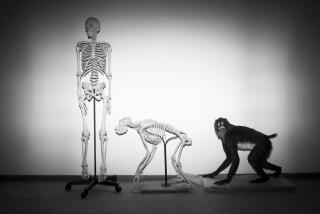Feathered baby dinosaur tail found trapped in amber

In Myanmar, scientists browsing amber markets discovered the feathers and partial tail of a tiny baby dinosaur. (Dec. 8, 2016)
While browsing amber markets in Myanmar, scientists discovered the feathers and partial tail of a tiny baby dinosaur that lived some 99 million years ago.
The find, described in the journal Current Biology, offers a rare window onto the structure and organization of dinosaur feathers — one that could help shed new light on their evolution.
Scientists have long studied feathers that pop up in the fossil record in part because they want to understand the origins of birds. Birds are thought to be the only living descendants of dinosaurs — and questions of how and when their ancestors first developed flight (and the feathers that enabled it) remain confounding mysteries.
In recent years, paleontologists have also realized that many dinosaurs were not scaly (a la Jurassic Park) but feathered like birds. However, their plumage’s original purpose (for example, for insulation or for camouflage) remains up for debate. Researchers want to understand the origin of feathers, as well as figure out how they eventually evolved for flight.
But there are limits to what they can learn from studying feathers in isolation, without seeing how they were positioned and organized on the body — and without knowing which species the feathers came from. And those preserved plumes found with fossil skeletons are typically compressed flat in the rock, which makes it difficult to know what the animal looked like in three dimensions.
This new fossil, encased in amber, solves all of those issues. Co-lead author Lida Xing of the China University of Geosciences discovered the fossil at an amber market in Myanmar last year. Because of its bushy appearance, the seller believed the tail to be some kind of trapped plant — but Xing believed differently and asked the Dexu Institute of Paleontology to purchase it.
“It wasn’t until Lida took a close look at it that he realized there were feathers coming off the side of the little filaments running through the amber,” said co-lead author Ryan McKellar, a paleontologist with the Royal Saskatchewan Museum in Regina, Canada. “That’s when the real fun began, from a research standpoint.”
Amber is a paleontologist’s best friend for many reasons: Among them, it insulates the fossil from chemical alteration by the environment and helps to preserve it in three dimensions.
“Amber is like nature’s plastic,” McKellar said. “It seals in a lot of information at the same time it’s basically drying out a lot of inclusions that end up in the resin.”
Xing, McKellar and colleagues CT-scanned the tail through the amber, studying its microscopic structure.
The partial tail, which probably belonged to a coelurosaur about the size of a sparrow, consists of eight full vertebra surrounded by highly preserved feathers. In birds, tailbones are fused together in what’s known as a pygostyle, which is why scientists think this one must have come from a non-avialan dinosaur.
“This flexible tail isn’t something that you see in modern birds, so it restricts you to a group of dinosaurs that are outside of archaeopteryx and modern birds,” McKellar said. “You have to be dealing with something lower down in the evolutionary tree. And this means you’re firmly in dinosaur territory, as opposed to bird territory.”
Unlike birds, the dinosaur’s feathers had an underdeveloped main stem, or rachis. The top feathers were dark and those on the underside were light, so it may have been used for camouflage or signaling, McKellar said.
There are limits to what this particular fossil can reveal about feathered dinosaurs, the scientist added – but it does show that more such fossils might well exist, mistaken for bushy plants or other debris, just waiting to be found. His colleagues, he added, were continuing to search amber markets, hoping to get lucky once again.
Follow @aminawrite on Twitter for more science news and “like” Los Angeles Times Science & Health on Facebook.
MORE SCIENCE NEWS
Scientists find antibody that hinders the spread of certain cancer cells
Cassini sends back intriguing pictures of Saturn from new ring-grazing orbit
On average, people born in the U.S. in 2015 will live 36.5 days less than those born in 2014






